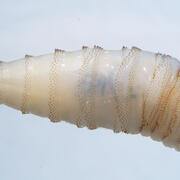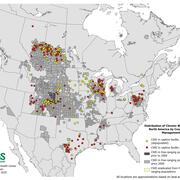Katie Richgels
Dr. Richgels is the Chief of the Ecology and Epidemiology Branch at the National Wildlife Health Center.
She received her Ph.D. from the University of Colorado at Boulder in 2014 and her Bachelor's degree in 2005 from the University of Wisconsin - Madison. Since joining the USGS in 2016, she has devoted her career to supporting project leaders who study wildlife diseases with the goal of helping state and federal partners better manage wildlife disease.
Professional Experience
2016 – Present Chief, Ecology and Epidemiology Branch, U.S. Geological Survey, National Wildlife Health Center, Madison, WI
2016 – 2014 Postdoctoral Researcher, U.S. Geological Survey, National Wildlife Health Center, and University of Wisconsin – Madison, Madison, WI
2014 – 2011 Graduate Research Fellow, Graduate Research Fellowship Program, National Science Foundation, University of Colorado at Boulder, Boulder, CO
2011 – 2008 Teaching and Research Assistant, University of Colorado at Boulder, Boulder, CO
2006 –2007 Spatial Analyst, First American Spatial Solutions, Madison, WI
Education and Certifications
Ph.D., Ecology and Evolutionary Biology, University of Colorado at Boulder, 2014
Certificate, GIS, University of Wisconsin - Madison, 2006
B.NS., Wildlife Ecology, University of Wisconsin - Madison, 2005
Affiliations and Memberships*
Bsal Task Force Decision Support Team
Interagency Committee on Invasive Terrestrial Animals and Pathogens, Invasive Pathogens Subcommittee
Black-footed Ferret Recovery Implementation Team – Executive Committee
Science and Products
Preparing for Potential Emergence of New World Screwworm in the U.S.
Expanding Distribution of Chronic Wasting Disease
Interagency coordination on coral health
White-nose syndrome diagnostic harmonization
Integrating Science and Management to Assist with the Response to Stony Coral Tissue Loss Disease
Epidemiological Services
Tracking Bats and Coronaviruses
Research in response to Florida’s emerging coral disease
Avian Influenza
Disease Ecology and Modeling
SARS-CoV-2 and Mpox virus spillback component data (North America, 2022) to create risk assessment of spillback at human-wildlife interface SARS-CoV-2 and Mpox virus spillback component data (North America, 2022) to create risk assessment of spillback at human-wildlife interface
USGS NWHC Diagnostic Case Data to retrospectively evaluate NWHC’s diagnosis likelihoods for different kinds of cases collected in the United States submitted to the NWHC from January 1st, 2000 to December 31st, 202 USGS NWHC Diagnostic Case Data to retrospectively evaluate NWHC’s diagnosis likelihoods for different kinds of cases collected in the United States submitted to the NWHC from January 1st, 2000 to December 31st, 202
Prairie dog trapping locations treated with plague or vaccine baits in western states Prairie dog trapping locations treated with plague or vaccine baits in western states
Plague causes fragmentation of prairie dog colonies in Conata Basin, South Dakota from 1993 - 2015 Plague causes fragmentation of prairie dog colonies in Conata Basin, South Dakota from 1993 - 2015
Sylvatic Plague Vaccine field trials flea data Sylvatic Plague Vaccine field trials flea data
Impact of the oral Sylvatic Plague Vaccine on Non-target Small Rodents: Data Impact of the oral Sylvatic Plague Vaccine on Non-target Small Rodents: Data
SPV field trials bait uptake data SPV field trials bait uptake data
Determinants of Pseudogymnoascus destructans within bat hibernacula: data Determinants of Pseudogymnoascus destructans within bat hibernacula: data
Field efficacy trials with sylvatic plague vaccine Field efficacy trials with sylvatic plague vaccine
Rapid risk assessment framework to estimate potential for spillback at human-wildlife interfaces Rapid risk assessment framework to estimate potential for spillback at human-wildlife interfaces
Applying the resist-accept-direct (RAD) framework to wildlife health management Applying the resist-accept-direct (RAD) framework to wildlife health management
Density estimation using spatial capture-recapture analyses: Application to vaccination of prairie dogs against sylvatic plague Density estimation using spatial capture-recapture analyses: Application to vaccination of prairie dogs against sylvatic plague
Evaluation of regulatory action and surveillance as preventive risk-mitigation to an emerging global amphibian pathogen Batrachochytrium salamandrivorans (Bsal) Evaluation of regulatory action and surveillance as preventive risk-mitigation to an emerging global amphibian pathogen Batrachochytrium salamandrivorans (Bsal)
Batrachochytrium salamandrivorans (Bsal) not detected in an intensive survey of wild North American amphibians Batrachochytrium salamandrivorans (Bsal) not detected in an intensive survey of wild North American amphibians
An invasive disease, sylvatic plague, increases fragmentation of black-tailed prairie dog (Cynomys ludovicianus) colonies An invasive disease, sylvatic plague, increases fragmentation of black-tailed prairie dog (Cynomys ludovicianus) colonies
Safe work practices for working with wildlife Safe work practices for working with wildlife
Human dimensions considerations in wildlife disease management Human dimensions considerations in wildlife disease management
Inactivation of viable surrogates for the select agents virulent Newcastle disease virus and highly pathogenic avian influenza virus using either commercial lysis buffer or heat Inactivation of viable surrogates for the select agents virulent Newcastle disease virus and highly pathogenic avian influenza virus using either commercial lysis buffer or heat
Successful molecular detection studies require clear communication among diverse research partners Successful molecular detection studies require clear communication among diverse research partners
One Health: A perspective from wildlife and environmental health sectors One Health: A perspective from wildlife and environmental health sectors
Response to “Prepublication communication of research results”: The need for a coordinated wildlife disease surveillance laboratory network Response to “Prepublication communication of research results”: The need for a coordinated wildlife disease surveillance laboratory network
Non-USGS Publications**
**Disclaimer: The views expressed in Non-USGS publications are those of the author and do not represent the views of the USGS, Department of the Interior, or the U.S. Government.
Science and Products
Preparing for Potential Emergence of New World Screwworm in the U.S.
Expanding Distribution of Chronic Wasting Disease
Interagency coordination on coral health
White-nose syndrome diagnostic harmonization
Integrating Science and Management to Assist with the Response to Stony Coral Tissue Loss Disease
Epidemiological Services
Tracking Bats and Coronaviruses
Research in response to Florida’s emerging coral disease
Avian Influenza
Disease Ecology and Modeling
SARS-CoV-2 and Mpox virus spillback component data (North America, 2022) to create risk assessment of spillback at human-wildlife interface SARS-CoV-2 and Mpox virus spillback component data (North America, 2022) to create risk assessment of spillback at human-wildlife interface
USGS NWHC Diagnostic Case Data to retrospectively evaluate NWHC’s diagnosis likelihoods for different kinds of cases collected in the United States submitted to the NWHC from January 1st, 2000 to December 31st, 202 USGS NWHC Diagnostic Case Data to retrospectively evaluate NWHC’s diagnosis likelihoods for different kinds of cases collected in the United States submitted to the NWHC from January 1st, 2000 to December 31st, 202
Prairie dog trapping locations treated with plague or vaccine baits in western states Prairie dog trapping locations treated with plague or vaccine baits in western states
Plague causes fragmentation of prairie dog colonies in Conata Basin, South Dakota from 1993 - 2015 Plague causes fragmentation of prairie dog colonies in Conata Basin, South Dakota from 1993 - 2015
Sylvatic Plague Vaccine field trials flea data Sylvatic Plague Vaccine field trials flea data
Impact of the oral Sylvatic Plague Vaccine on Non-target Small Rodents: Data Impact of the oral Sylvatic Plague Vaccine on Non-target Small Rodents: Data
SPV field trials bait uptake data SPV field trials bait uptake data
Determinants of Pseudogymnoascus destructans within bat hibernacula: data Determinants of Pseudogymnoascus destructans within bat hibernacula: data
Field efficacy trials with sylvatic plague vaccine Field efficacy trials with sylvatic plague vaccine
Rapid risk assessment framework to estimate potential for spillback at human-wildlife interfaces Rapid risk assessment framework to estimate potential for spillback at human-wildlife interfaces
Applying the resist-accept-direct (RAD) framework to wildlife health management Applying the resist-accept-direct (RAD) framework to wildlife health management
Density estimation using spatial capture-recapture analyses: Application to vaccination of prairie dogs against sylvatic plague Density estimation using spatial capture-recapture analyses: Application to vaccination of prairie dogs against sylvatic plague
Evaluation of regulatory action and surveillance as preventive risk-mitigation to an emerging global amphibian pathogen Batrachochytrium salamandrivorans (Bsal) Evaluation of regulatory action and surveillance as preventive risk-mitigation to an emerging global amphibian pathogen Batrachochytrium salamandrivorans (Bsal)
Batrachochytrium salamandrivorans (Bsal) not detected in an intensive survey of wild North American amphibians Batrachochytrium salamandrivorans (Bsal) not detected in an intensive survey of wild North American amphibians
An invasive disease, sylvatic plague, increases fragmentation of black-tailed prairie dog (Cynomys ludovicianus) colonies An invasive disease, sylvatic plague, increases fragmentation of black-tailed prairie dog (Cynomys ludovicianus) colonies
Safe work practices for working with wildlife Safe work practices for working with wildlife
Human dimensions considerations in wildlife disease management Human dimensions considerations in wildlife disease management
Inactivation of viable surrogates for the select agents virulent Newcastle disease virus and highly pathogenic avian influenza virus using either commercial lysis buffer or heat Inactivation of viable surrogates for the select agents virulent Newcastle disease virus and highly pathogenic avian influenza virus using either commercial lysis buffer or heat
Successful molecular detection studies require clear communication among diverse research partners Successful molecular detection studies require clear communication among diverse research partners
One Health: A perspective from wildlife and environmental health sectors One Health: A perspective from wildlife and environmental health sectors
Response to “Prepublication communication of research results”: The need for a coordinated wildlife disease surveillance laboratory network Response to “Prepublication communication of research results”: The need for a coordinated wildlife disease surveillance laboratory network
Non-USGS Publications**
**Disclaimer: The views expressed in Non-USGS publications are those of the author and do not represent the views of the USGS, Department of the Interior, or the U.S. Government.
*Disclaimer: Listing outside positions with professional scientific organizations on this Staff Profile are for informational purposes only and do not constitute an endorsement of those professional scientific organizations or their activities by the USGS, Department of the Interior, or U.S. Government











